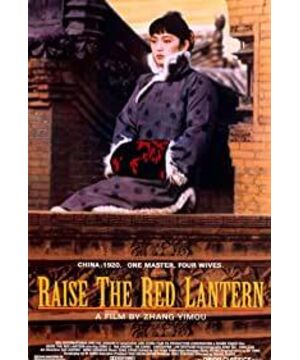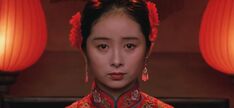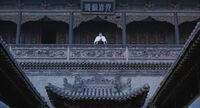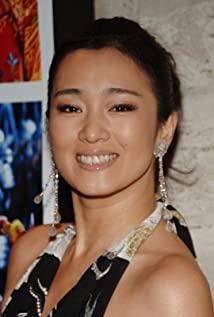color tones in the
whole film
[img=1:C]
[/img]
The warm tone of Song Lian just entered the Chen residence in the early stage.
Big red tones
[img=3:C]
[/img]
Dark cool tones
The all-white tone after the death of the third wife
hints respectively: 1. Songlian still has a rebellious mentality when she first entered the Chen Mansion, and has not been assimilated by the system.
2. Songlian was gradually assimilated, and began to compete for the opportunity to light the lamp, participating in the struggle between wives.
3. Song Lian realizes that Chen Mansion is a murder cage, but cannot escape, sad.
4. At the climax of the whole film, the third wife was killed, and the funeral-like Bai Xue was both a sympathy and an accusation against the backward system. Songlian's spirit of resistance was completely dead and mad.
strong color contrast
The contrast between the red lantern and the dark cage
At this time, Songlian first entered the Chen Mansion, and the wall trapped several lights that symbolized resistance, and there was nowhere to escape. Because her stepmother was greedy for money, Songlian was sent to prison.
[img=6:C]
[/img]
The contrast between
Song Lian's white clothes and the cage Song Lian has not yet participated in the wives' jealousy. She is still "clean" and retains her humanity. In contrast to the omnipotence of the later false pregnancy, and the vicious heart of the second wife.
The contrast between the lantern and the cage
Where the lantern is, the master will go. Song Lian recognized the true face of the second wife. Songlian began to engage in the struggle.
The contrast between brightly colored red shoes and white trousers.
The rubbing feet suggest sexual desire. Which room lights up, which room hammers feet. Not just a thirst for hammer feet, but a thirst for power. The beginning of Songlian's depravity begins with her feet.
The contrast between light and cage.
The light appears, love is budding, and there is still hope in life, the eldest son Feipu awakens Songlian's emotions.
The contrast between red and white is
red, white and yellow, which is very visually beautiful. The little people under the system died in the fire.
[img=11:C]
[/img]
The contrast between the lantern and the cage, the white clothes of resistance and the white clothes of death are contrasted and
superimposed. It is obvious that the contrast between the past and the present, a girl with great personality is finally unable to withstand the heavy pressure, her humanity has been destroyed, and her spirit has died. In the cage can only keep wandering, can not find a way to escape.
The lantern symbolizes vitality as well as defiance. At the beginning, Songlian's vitality was in herself, and later it was transferred to the master. The lantern turned into an empty shell, and the red light was still on, but the man died, and the flame of resistance was extinguished. The bright red becomes irony, making the tragedy even more tragic. cannibalistic society. The photographer who
composes the
film is Zhao Fei, who has filmed "Let the Bullets Fly" and "The Forbidden City", and has cooperated with Zhang Yimou, Chen Kaige and Jiang Wen many times, and the photography level is very high. The shooting method of this film is very Zhang Yimou's style, the square composition, the very deep sense of the lens, very suitable for the theme of this film. As early as in "The Yellow Earth", Zhang Yimou made a bold attempt at composition - raising the horizon, the loess occupies most of the shots, and the characters are squeezed between the horizon and the sky, making them look extraordinarily small. In order to reflect the vastness of the earth, people were born in the loess, died in the loess, and lived on this soil from generation to generation. The composition of this film is mostly axisymmetric. The courtyard of the Chen Mansion is square and upright, and the interior and exterior of the house are neat and tidy. Just like the invisible rules and regulations of the Chen Mansion, they are strictly untouchable, and power is concentrated in In the hands of the ruler, the women and servants all serve the master. "People are just a breath away from ghosts, people are ghosts, and ghosts are people." Here, people live without dignity.
Another feature of film composition is a strong sense of depth.
A house with one layer on top, one layer thicker than one layer of prison walls. The characters are oppressed in a cramped space, unable to escape.
The film makes good use of the roof of the Qiao's compound. Zhang Yimou did not take people as the main body of the camera. Similar to "Yellow Earth", the director used more space to shape the environment, showing a "cage feeling". The picture above shows the third wife singing on the roof.
House of the Dead.
silhouette, sunset. Symbolizes the decay of life.
This shot is exactly the same as the scene of the denunciation meeting in "Farewell My Concubine", which is to express the characters through flames. On the contrary, "Ba" shows Duan Xiaolou's overwhelmed collapse, and "Big" shows Yan'er's determination to die. Yan'er is a victim of the feudal family system of the Chen Mansion. She longs to be a wife and is hostile to Song Lian, but she eventually dies of her own obsession.
The big red lantern is just a tool used by Master Chen to imprison women. The master gives you the power to eat, the power to hammer your feet, and the power to command the servants. In the house, the girl becomes a wife, and the wife becomes a ghost, guarding the sky above her head all her life, and she will never be able to get out of that gate. The film deliberately blurred the appearance of the master, and did not give the frontal shots, but mostly portrayed the backrest and voice-over. The intention is obvious. In addition to Master Chen, there will also be Master Li, Master Zhang, and thousands of masters, all of whom are killing people. In the final analysis, it is still a big problem in feudal society. If society is not fundamentally changed, women will still not be able to step out of the cage.
above.
View more about Raise the Red Lantern reviews











